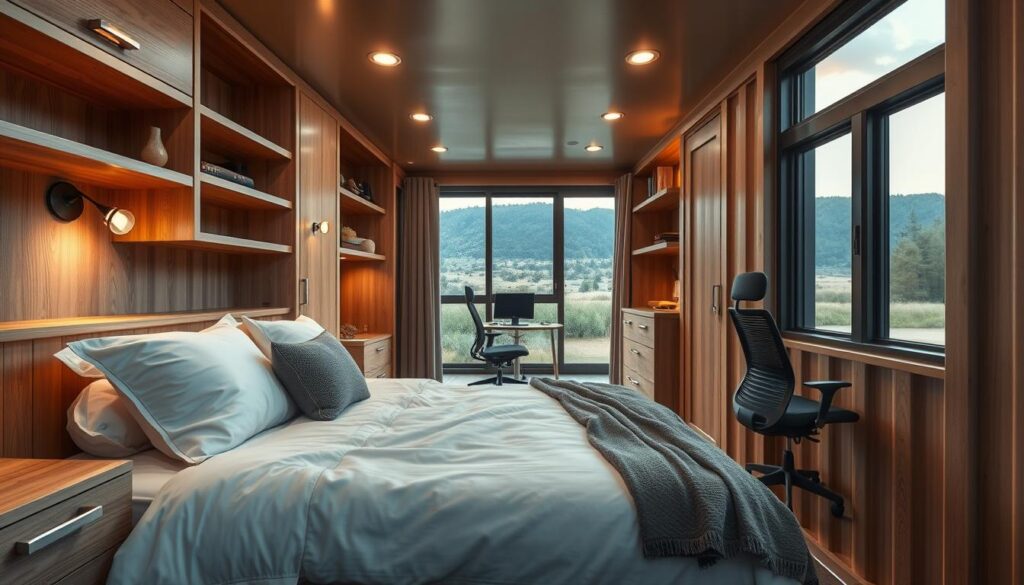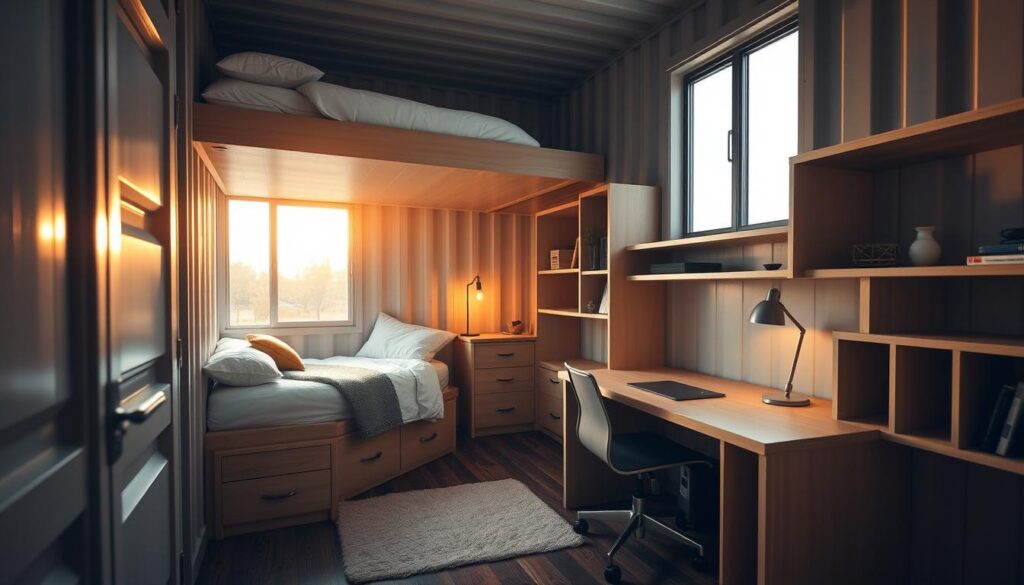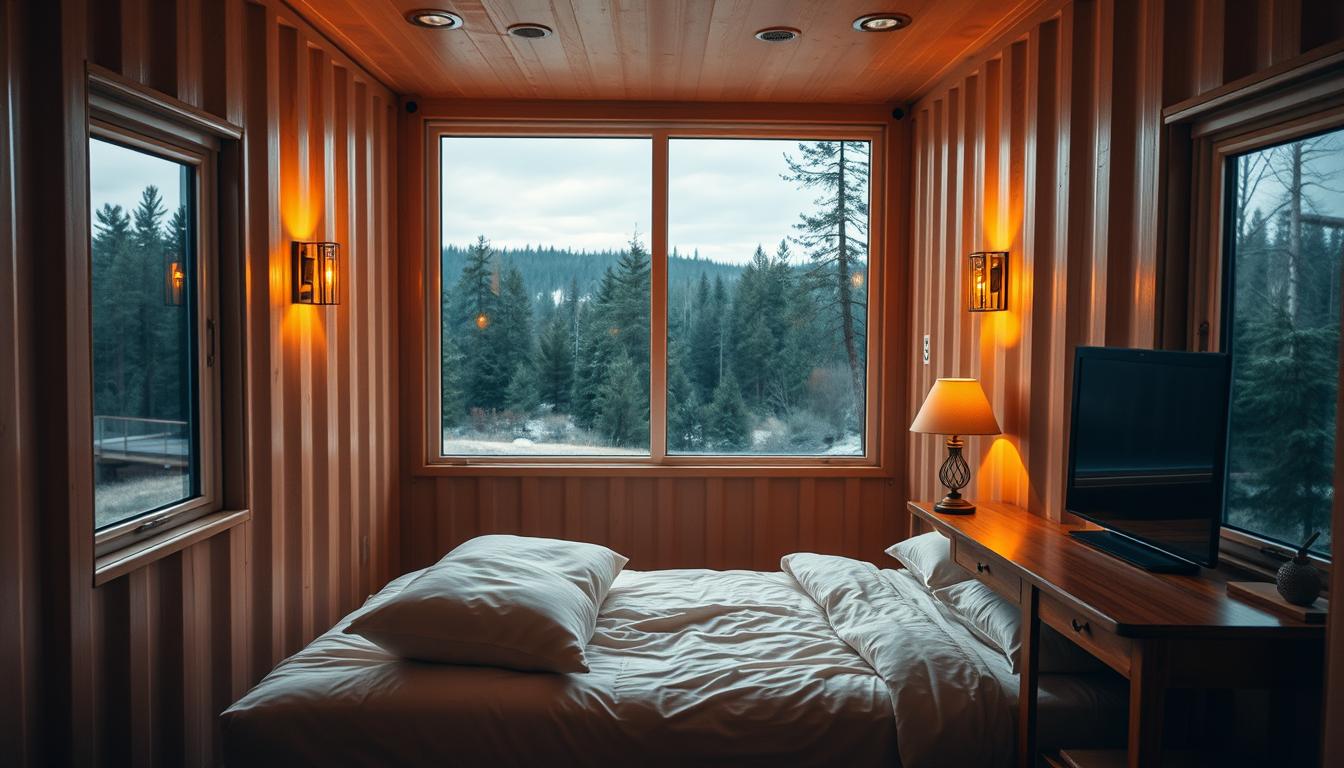Shipping container homes are gaining popularity due to their sustainability and customization options. One of the most appealing aspects of these homes is the potential to transform shipping containers into cozy bedrooms.
These unique bedrooms offer a blend of eco-friendliness, durability, and flexibility, making them an attractive choice for those looking for an unconventional sleeping space. With the right design, a shipping container can be converted into a cozy retreat that meets individual needs and preferences.
The process of transforming containers into cozy bedrooms involves careful planning and design. By incorporating elements like natural light, comfortable furnishings, and personalized touches, it’s possible to create a warm and inviting atmosphere within a shipping container.
Key Takeaways
- Eco-friendly and sustainable living option
- Customizable design to suit individual needs
- Durable and flexible structure
- Potential for unique and cozy bedroom designs
- Opportunity to incorporate personalized touches
- Careful planning required for successful transformation
The Rise of Container Living: Why Choose a Shipping Container Bedroom
The growing trend of container living has sparked interest in shipping container bedrooms due to their eco-friendly and cost-effective advantages. As more people look for sustainable living options, shipping container homes, particularly bedrooms, are gaining popularity.
Sustainability and Eco-Friendly Benefits
One of the primary reasons for choosing a shipping container bedroom is its sustainability. Repurposing shipping containers reduces the need for new building materials and minimizes waste.
Reducing Carbon Footprint Through Repurposing
By repurposing shipping containers, we reduce the carbon footprint associated with traditional construction methods. This approach also gives old containers a new life, contributing to a more circular economy.
Minimizing Construction Waste
Container living minimizes construction waste as the primary structure is already built. This method significantly reduces the environmental impact compared to traditional building techniques.
Cost-Effectiveness Compared to Traditional Construction
Shipping container bedrooms are cost-effective container bedroom solutions that offer a budget-friendly alternative to traditional construction. The use of existing containers cuts down on material costs, making it an attractive option for those looking to save on construction expenses.
Flexibility and Mobility Advantages
Container bedrooms offer the advantage of flexibility and mobility. They can be easily relocated or modified according to changing needs, making them an innovative container bedroom idea for those who value adaptability. For more insights on maximizing space, visit our guide on two-bedroom shipping container homes.
Planning Your Shipping Container Bedroom Project
Before diving into your shipping container bedroom project, it’s essential to lay the groundwork with thorough planning and research. This foundational step will help you navigate the complexities of converting a shipping container into a cozy and functional bedroom.
Selecting the Right Container Size and Type
The first step in planning your shipping container bedroom is selecting the right container size and type. This decision will significantly impact the overall livability and functionality of your bedroom.
Standard vs. High Cube Containers
Shipping containers come in various sizes, but the most common options for bedrooms are standard and high cube containers. Standard containers offer a height of 8 feet 6 inches, while high cube containers provide an extra foot of height, making them ideal for those who need more vertical space.
| Container Type | Height | Ideal For |
|---|---|---|
| Standard | 8 feet 6 inches | Compact spaces, minimalist designs |
| High Cube | 9 feet 6 inches | Taller individuals, added storage or loft spaces |
New vs. Used: Making the Right Choice
Another critical decision is whether to opt for a new or used shipping container. New containers offer a clean slate and come with a warranty, while used containers can be more budget-friendly but may require additional inspections and repairs.
“Used shipping containers can be a cost-effective option, but it’s crucial to inspect them thoroughly for any signs of damage or wear.”
Understanding Local Building Codes and Permits
Understanding and complying with local building codes and securing the necessary permits is a crucial aspect of your shipping container bedroom project. Failure to do so can result in costly fines and project delays.
- Research local building codes and zoning regulations
- Obtain necessary permits before commencing construction
- Schedule inspections as required by local authorities
Budgeting for Your Container Bedroom Conversion
Creating a realistic budget is vital for the success of your shipping container bedroom project. It’s not just about the initial purchase or rental cost of the container.
Hidden Costs to Consider
Beyond the obvious costs, there are several hidden expenses to factor into your budget, including insulation, electrical and plumbing installations, and interior finishing.
Creating Comfortable Bedrooms in a Shipping Container
Creating a comfortable bedroom in a shipping container involves addressing unique challenges and leveraging innovative design solutions. To achieve a restful and inviting space, it’s crucial to balance aesthetics with functionality while tackling common comfort issues.
Balancing Aesthetics with Functionality
A shipping container bedroom must be both visually appealing and functional. This balance can be achieved by selecting furniture that serves multiple purposes and incorporating design elements that enhance the space’s ambiance. For instance, choosing multi-functional furniture can help maximize space while maintaining a stylish interior.
For more ideas on maximizing space, you can explore designs for 2-bedroom container homes, which often feature clever layout strategies.
Addressing Common Comfort Challenges
Two significant comfort challenges in shipping container bedrooms are overcoming the “box” feel and addressing sound dampening. Let’s explore these issues in more detail.
Overcoming the “Box” Feel
The inherent rectangular shape of shipping containers can sometimes feel confining. To mitigate this, consider using:
- Curved or angled design elements to soften the space
- Light colors on walls and ceilings to create a sense of openness
- Strategic placement of mirrors to enhance the perception of space
Sound Dampening Solutions
Metal containers can be noisy, especially during rainfall or in high-traffic areas. Effective sound dampening can be achieved through:
- Adding insulation materials like spray foam or fiberglass
- Incorporating sound-absorbing materials such as acoustic panels
- Using area rugs and heavy curtains to reduce echo
“The key to a comfortable shipping container bedroom is not just in the initial conversion but in the thoughtful details that make it feel like home.”
Designing for Different Climate Conditions
Climate plays a significant role in the comfort of a shipping container bedroom. In colder climates, effective insulation and heating solutions are crucial, while in warmer climates, cooling strategies and ventilation become more important. For example, in hot regions, incorporating shading devices and cross-ventilation techniques can significantly enhance comfort.
By thoughtfully addressing these aspects, you can create a shipping container bedroom that is not only comfortable but also stylish and inviting, regardless of the climate.
Essential Modifications for Livability
Transforming a shipping container into a cozy bedroom requires thoughtful modifications to enhance livability. To make a shipping container bedroom comfortable and inviting, it’s crucial to focus on elements that improve the internal environment.
Windows and Natural Light Solutions
Windows are a critical modification for introducing natural light into a shipping container bedroom. Proper placement of windows can significantly enhance the ambiance and make the space feel larger.
Placement Strategies for Optimal Lighting
Strategically placing windows to capture natural light is essential. Consider the direction of sunlight and place windows accordingly to maximize natural illumination.
Energy-Efficient Window Options
Choosing energy-efficient windows can help regulate the internal temperature of the container bedroom. Double-glazed windows are a popular choice for their ability to insulate and reduce energy costs.
Door Options and Placement Strategies
The placement and type of door can greatly affect the functionality and comfort of a shipping container bedroom. Sliding doors are a popular option as they save space and provide easy access.
Ventilation Systems for Healthy Air Quality
Adequate ventilation is vital for maintaining healthy air quality within a shipping container bedroom.
“Proper ventilation systems can prevent moisture buildup and reduce the risk of mold.”
Installing vents or a ventilation system can significantly improve air circulation.

Insulation and Climate Control Techniques
To enjoy a shipping container bedroom year-round, effective insulation and climate control techniques are essential. Proper insulation helps maintain a comfortable temperature inside the container, reducing the need for excessive heating or cooling.
Effective Insulation Materials for Metal Containers
Choosing the right insulation material is crucial for metal containers. The material should provide excellent thermal resistance, be durable, and resistant to moisture.
Spray Foam vs. Panel Insulation
Spray foam insulation offers high R-value per inch and can fill gaps and cavities effectively. Panel insulation, on the other hand, is easier to install and can be more cost-effective.
- Spray Foam: High R-value, fills gaps, but can be expensive.
- Panel Insulation: Cost-effective, easy to install, but may not fill gaps as well.
Eco-Friendly Insulation Alternatives
For those looking for eco-friendly options, materials like recycled denim, wool, and plant-based insulation are viable alternatives.
| Insulation Material | R-Value | Eco-Friendliness |
|---|---|---|
| Spray Foam | 6.0-7.0 per inch | Low |
| Panel Insulation | 4.0-6.0 per inch | Medium |
| Recycled Denim | 3.5-4.0 per inch | High |
Heating Solutions for Cold Climates
In colder climates, effective heating solutions are necessary to maintain a comfortable temperature. Options include radiant floor heating and portable heaters.
Cooling Strategies for Warm Regions
For warmer regions, cooling strategies such as passive cooling design elements can significantly reduce the need for air conditioning.
Passive Cooling Design Elements
Passive cooling involves designing the container to maximize natural ventilation and shading. This can include large overhangs, shading devices, and strategic window placement.
By incorporating these insulation and climate control techniques, a shipping container bedroom can be transformed into a cozy and comfortable living space, regardless of the external climate.
Maximizing Space in Your Container Bedroom
Maximizing space in a shipping container bedroom is all about smart design and functionality. When converting a shipping container into a bedroom, it’s essential to optimize the available space to create a comfortable and relaxing environment.
Smart Layout Designs for Small Spaces
A well-planned layout is crucial in a shipping container bedroom. Consider a layout that promotes flow and functionality. One effective strategy is to divide the space into zones, such as a sleeping area, a reading nook, and a workspace.
Using a neutral color palette can also help create the illusion of more space. Additionally, incorporating mirrors strategically can make the room appear larger.
Multi-Functional Furniture Solutions
Multi-functional furniture is a game-changer in small spaces. It serves more than one purpose, reducing clutter and increasing functionality.
Beds with Built-in Storage
Beds with built-in storage are an excellent choice for container bedrooms. They provide a place to sleep and store clothing, linens, or personal items, keeping the floor clear and reducing clutter.
Transformable Furniture Ideas
Transformable furniture, such as a desk that converts into a dining table or a sofa bed, can greatly enhance the versatility of your container bedroom.
Creative Storage Ideas for Container Living
Effective storage is vital in container living. One innovative solution is to utilize vertical space.
Utilizing Vertical Space Effectively
Installing shelves, storage units, or hanging organizers that go up to the ceiling can significantly increase storage capacity without encroaching on floor space.
Here’s a comparison of different storage solutions for container bedrooms:
| Storage Solution | Benefits | Space Requirement |
|---|---|---|
| Under-bed storage | Utilizes dead space, keeps floor clear | Low |
| Vertical shelving | Maximizes vertical space, easy access | Minimal floor space |
| Multi-functional furniture | Serves multiple purposes, reduces clutter | Variable |

By incorporating smart layouts, multi-functional furniture, and creative storage solutions, you can maximize the space in your shipping container bedroom, creating a cozy and functional retreat.
Interior Design and Personalization
Transforming a shipping container into a cozy bedroom requires thoughtful interior design and personal touches. The key to a stylish and comfortable container bedroom lies in balancing functionality with aesthetic appeal.
Wall Treatments and Finishing Options
The raw, metal walls of a shipping container can be a challenge to work with, but there are several ways to make them more inviting. One popular option is to install drywall, which provides a smooth surface for painting or wallpapering.
Drywall vs. Alternative Wall Coverings
While drywall is a common choice, alternative wall coverings such as reclaimed wood or decorative panels can add unique character to your container bedroom. For instance, exploring container trends can provide inspiration for using unconventional materials.
Flooring Choices for Container Bedrooms
Flooring is another critical aspect of interior design in a shipping container bedroom. Options range from hardwood and laminate to tile and carpet, each offering different benefits in terms of durability, comfort, and style.
Color Schemes and Décor Strategies
The right color scheme and décor can make a shipping container bedroom feel cozy and personalized. Light colors can help reflect what little natural light is available, making the space feel larger.
Creating the Illusion of Space Through Color
Using lighter shades on walls and ceilings can create the illusion of more space. Additionally, strategic placement of mirrors can enhance this effect by reflecting light and images.
Textures and Materials That Work in Container Spaces
Incorporating a variety of textures and materials can add depth and visual interest to a container bedroom. Consider combining smooth surfaces like drywall with rougher textures like reclaimed wood to create a visually appealing contrast.
By thoughtfully selecting wall treatments, flooring, color schemes, and décor, you can turn a shipping container into a cozy and stylish bedroom that reflects your personal style.
Electrical, Plumbing, and Technology Integration
The key to a livable shipping container bedroom lies in effectively integrating electrical, plumbing, and technological elements. This integration not only enhances comfort but also modernizes the space, making it suitable for daily living.
Power Solutions for Container Bedrooms
When it comes to powering a shipping container bedroom, homeowners have several options to consider. The choice between grid-connected and off-grid solutions depends on the container’s location and the homeowner’s preferences.
Grid-Connected vs. Off-Grid Options
Grid-connected systems are ideal for containers placed in areas with existing electrical infrastructure. They offer reliability and consistency. On the other hand, off-grid solutions, such as solar panels, provide independence from public utilities, making them perfect for remote locations.
Smart Home Features for Modern Container Living
Incorporating smart home technology can significantly enhance the living experience in a shipping container bedroom. From automated lighting to climate control, these features contribute to a more comfortable and efficient living space.
Space-Saving Technology Integration
To maintain the compact nature of container living, it’s essential to choose technology that is not only functional but also space-efficient. Compact smart home devices and wireless controls are ideal for minimizing clutter.
Plumbing Considerations for Attached Bathrooms
For containers with attached bathrooms, plumbing is a critical consideration. Proper planning and installation of water supply and drainage systems are essential for hygiene and comfort.
| Aspect | Grid-Connected | Off-Grid |
|---|---|---|
| Reliability | High | Variable |
| Cost | Lower Initial Cost | Higher Initial Cost |
| Independence | Low | High |
By carefully considering these factors and integrating the right systems, a shipping container bedroom can be both comfortable and technologically advanced.
Conclusion: Embracing the Container Bedroom Lifestyle
Embracing a shipping container bedroom is not just about adopting a new way of living; it’s about revolutionizing your space with sustainability and innovation. By understanding the benefits of eco-friendly container bedroom designs and the process of Creating Comfortable Bedrooms in a Shipping Container, you can transform a simple metal box into a cozy retreat.
The journey to a shipping container bedroom involves careful planning, from selecting the right container size to integrating essential modifications for livability. With the right shipping container bedroom design, you can enjoy a unique blend of functionality and aesthetics, all while reducing your environmental footprint.
As you’ve seen, the possibilities are vast, from maximizing space with smart layouts to incorporating smart home features. Whether you’re looking for a serene escape or a modern living solution, shipping container bedrooms offer a compelling alternative to traditional housing.
By choosing this path, you’re not only enhancing your living experience but also contributing to a more sustainable future. So, take the first step towards embracing the container bedroom lifestyle and discover the comfort and innovation it has to offer.

